AMD’s Radeon HD 5770 & 5750: DirectX 11 for the Mainstream Crowd
by Ryan Smith on October 13, 2009 12:00 AM EST- Posted in
- GPUs
Power, Temperature, & Noise
With the 5700 series being built using TSMC’s 40nm process, and with their low target power, we should see some interesting results here.
We do need to note however that thanks to some badly timed broken hardware, we’re using our secondary test rig for noise and temperature data, so the results are not directly comparable to our 5800 series reviews. As a result we also only have power data for the 5770; we weren’t able to get power data on the 5750 in time for this article.
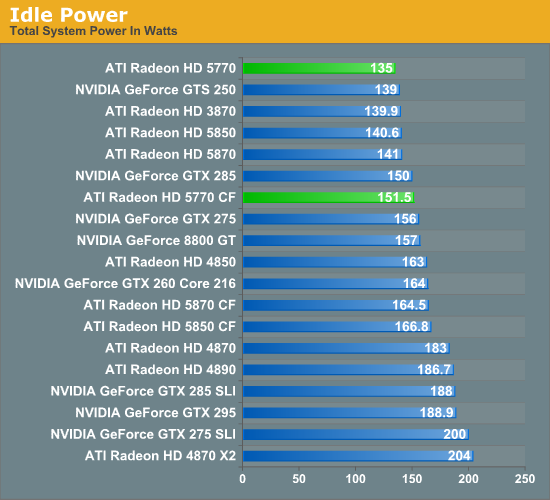
Thanks to the 40nm process and relatively simple nature of Juniper, the 5770 turns in the best idle power usage of all of our mainstream and high-end cards. At 135W it edges out the GTS 250, the 3870, and its bigger brothers the 5800 series. Coupled with a good CPU, and this should result in a system with very good idle power usage for the performance levels it provides.
We can also see the low power usage of an individual 5770 in our 5770 CF usage. There's a 16.5W difference, as the slave card gets to power down even further than 18W.

At 256W for load power, the 5770 isn’t quite the winner here like it is for idle power. The 3870 beats it by 14W at the cost of a significant degree of performance, while the 8800GT is neck-and-neck with the 4770, again with a decent-sized performance gap. Everything past here approaches 300W and beyond. As a result, even if it’s not the least power hungry card we have, it’s very close, and it’s certainly among the best for on a power-to-performance ratio.
Meanwhile looking at the Crossfire results, we see that there's a 134W difference between cards. As the Evergreen architecture allows us to go higher so long as the VRMs are safe, this appears to that situation in action.
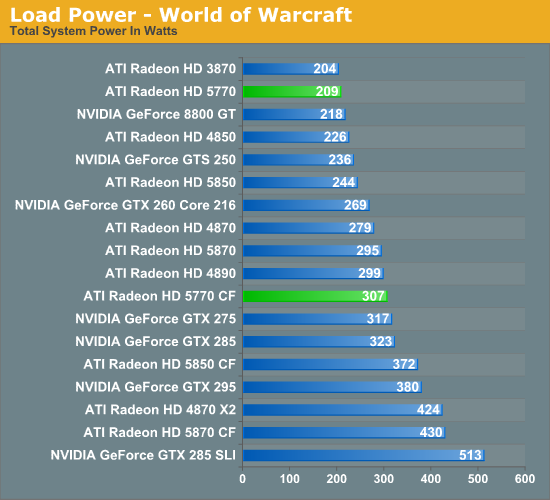
World of Warcraft gives us similar results. The 5770 still doesn’t come out on top, but its bested only by the 3870 and its significantly lower performance. The gap on the other side isn’t particularly large either, but the first card that can beat the 5770’s average gaming performance doesn’t show up until we hit the 5850.
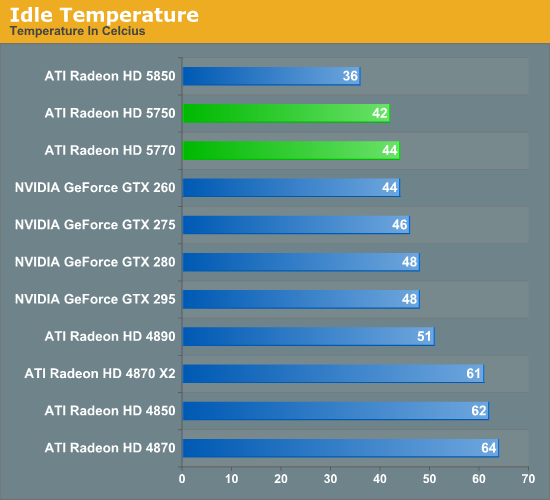
The 5700 series turns in some of our best idle temps, tying or beating everything besides a 5850. In fact we’re a bit surprised to see a 5850 win here given the lower idle power usage of the 5700 series, but the data doesn’t lie.
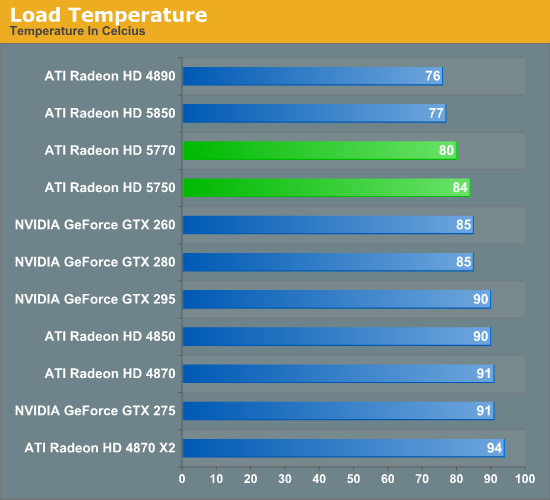
It’s load temperatures where all of the action is at. Again the 5700 series do quite well here, only losing to the 5850 and a very loud 4890. Compared to the rest of the 4800 series in particular, we’re a good 6C-11C cooler for a set of cards that offer similar to slightly less performance. Aren’t smaller manufacturing processes great?
However in spite of the 5750’s lower power consumption, it doesn’t do so well here in terms of temperature compared to the 5770, coming in 4C hotter. We’re going to chalk it up to the egg cooler being unable to match the 5770’s shrouded cooler. This of course makes the fact that the 5770’s shrouded cooler is going to eventually go away all the more meaningful, as conceivably the replacement coolers would end up being less effective.
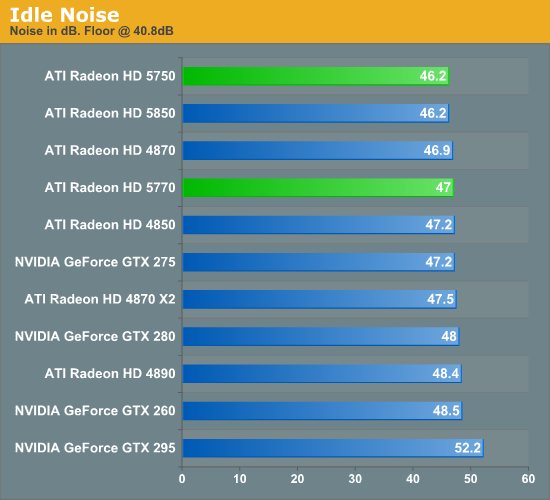
As is the case for most of the cards we test, at idle they’re virtually all the same. The 5700 series are no exception to this rule.
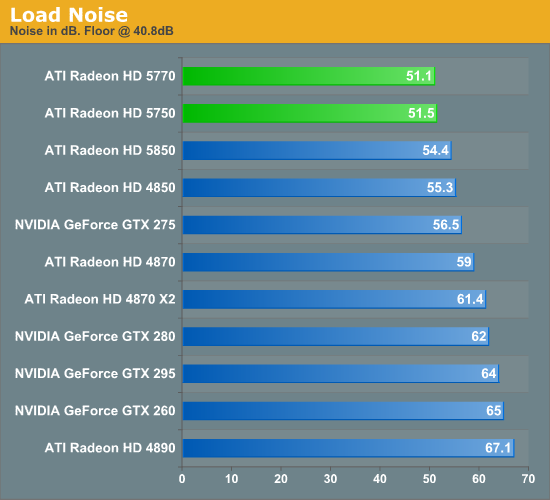
With the low power consumption of the 5700 series, their coolers don’t have to work very hard to reach their already low load temperatures. At 51dB, these are the quietest cards we’ve tested at this level of performance; we would need to drop down to something slower yet (like yesterday’s GT 220) to find something quieter.
We also can’t rule out the possibility of the 5750 going passive in the future, given its already dainty cooler. We’ve seen it done before on an 8800GT, which has a similar thermal envelope. This certainly has all the makings of the fastest passively cooled card on the market, if someone can build the right cooler.
This also leaves the door open to the idea of using the 5750 as an HTPC card. With bitstreaming audio support it’s the best HTPC card we’ve tested yet from a features standpoint, but we’re not convinced that it’s going to be the best thing out there given it’s >$100 price tag and the fact that it’s still power-hungry enough to need a PCIe power connector. In the long-term the 5600 series may be a better replacement given the same features and lower power consumption that a lower-performing part will offer, but that’s something we won’t be able to test until next year.










117 Comments
View All Comments
hsoverma - Tuesday, October 13, 2009 - link
I bought a 3870 for about 210.00 a year and a half ago. This card has double the performance, a lot more features, and is starting at 160.00. I figure by christmas, it will be down around 120.00. I run a small frag-box, so the lower heat and lower power makes sense for me over a 4870, and if I ever wanted more power, I could run two of these in crossfire and have all that I need. I am putting this card on my wish-list. Thanks again for a great review.7Enigma - Tuesday, October 13, 2009 - link
Great article except for the flaw of not a single Memory OC data point. If as the data shows the 5770 is performing poorly due to inadequate memory bandwidth (seemingly the ONLY issue hampering performance when comparing specs between it and the 4870), it makes sense that a simple OC could shed some light on this issue. Please update the article with some numbers as this card is mainstream enough that I would imagine overclockers *could* see this as a gem in disguise.Ryan Smith - Tuesday, October 13, 2009 - link
Once things calm down, we're going to do a 5800 series overclocking article. It's something that takes a while to put together, and there are major product launches every week right up through the end of this month.7Enigma - Wednesday, October 14, 2009 - link
Can you give us a hint then whether this memory has the potential to overclock well enough to where the bottleneck is overcome? I doubt it can completely remedy the situation but if the memory overclock was enough to make up for the significantly narrower bus in most cases, I think this card would have a better reception.Etern205 - Tuesday, October 13, 2009 - link
Just a stupid question...ATi's Eyefinity requires a display port monitor to work properly (saw on youtube video), and what it does is makes the image share across the screen.
My question is can you use the ATi card and use all monitors independently without the eyefinity feature?
squeezee - Tuesday, October 13, 2009 - link
Yes, you can run the displays independantly just as with any other card. However the 3rd monitor always needs to be Displayport. (or use an ACTIVE displayport adapter)EJ257 - Tuesday, October 13, 2009 - link
I'm sure there is a perfectly good explanation for this that I'm missing. You say there is 1 SIMD disabled in the 5750 vs the 5770. Looking at the chart on the first page there is a difference of 80 stream processors and 4 texture units between the 5750 & 5770 so this would indicate 4 SIMDs are disabled.EJ257 - Tuesday, October 13, 2009 - link
Wait, never mind. I see each SIMD consists of 4 texture units and 20 SP (Stream Processors) and each SP contains 4 Stream Cores. I guess in the chart when you say Stream Processors you really mean Stream Cores right?yacoub - Tuesday, October 13, 2009 - link
Ryan - THANK YOU for including the 8800GT in the graphs: That is the card I (and many other potential buyers) will be upgrading from, moving to a DX11 card.It's too bad this new card (5770) can't quite catch the GTX260 C216, as that is its main NVidia competitor in performance and price. It uses just as much Load wattage as a 260, but seems to offer around 80-90% of the performance. Perhaps if they hadn't cut the bandwidth to 128-bit, it would have squashed the GTX-260. But ATI has a habit of under-bussing their cards and it continues to negatively impact high resolution performance, no matter what certain reviewers might claim about the bus-width not hurting performance. Time and again, testing shows potential for improvement from a wider bus.
Blah. ATI, you always come so close to getting me to purchase but there's always something to hold me back. Perhaps if/when this card drops to $139 (without rebates). But by then NVidia might have their answer out and the GTX-260 would also drop in price or be replaced with a DX11 part, and then the 5770 again loses appeal.
MadMan007 - Tuesday, October 13, 2009 - link
I think you'll pass out if you try to hold your breath waiting for a lower midrange NV DX11 answer to these cards.